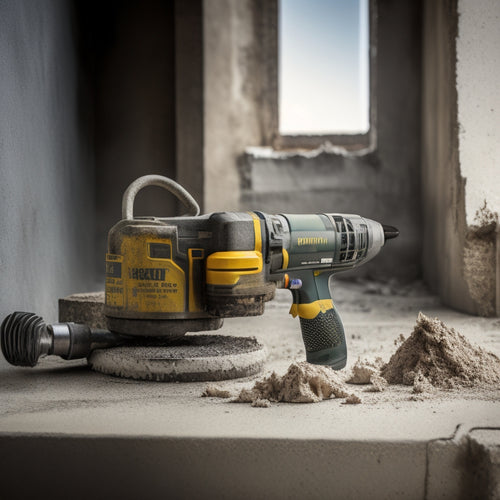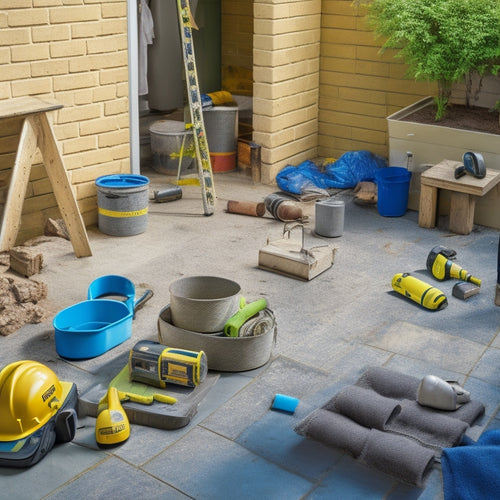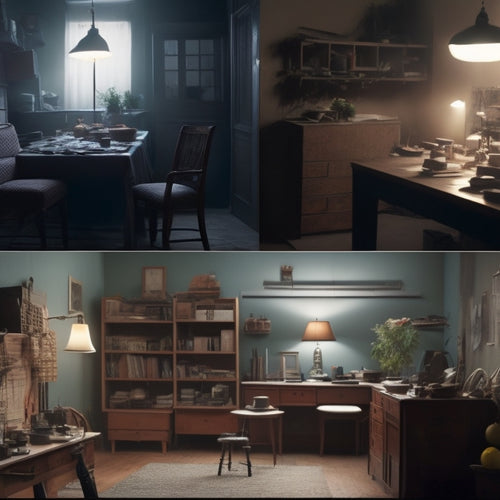
Complete Plastering Tool Kit for Home Renovations
Share
When tackling a home renovation project, you'll need a thorough set of specialized tools to guarantee a professional-looking finish. A complete plastering tool kit should include essential items like hawks, trowels, and mixing tools for efficient application, as well as smoothing and finishing tools for a flawless finish. Measuring and marking tools, such as tape measures and laser levels, will help you achieve accurate results. Don't forget safety equipment, including protective gear and eye and face shields, to prevent injuries. With these tools at your disposal, you'll be well on your way to achieving a stunning, professional-looking finish - and there's more to discover to take your project to the next level.
Key Takeaways
- A complete plastering tool kit should include essential tools like hawks, trowels, and mixing tools for efficient application and finishing.
- Measuring and marking tools like tape measures, combination squares, and laser levels ensure accurate room measurements and aligned surfaces.
- Safety equipment such as protective gear, respiratory masks, and eye and face shields are crucial for preventing injuries and health risks.
- Specialized tools for corners, including corner trowels, angle brushes, and plastering corner beads, help achieve professional-looking results in challenging areas.
- A well-rounded kit should also include smoothing tools, like putty knives and finishing blades, for achieving smooth, even finishes on large flat areas and intricate spaces.
Essential Tools for Lime Plastering
When tackling a lime plastering project, you'll need a solid arsenal of essential tools to achieve a smooth, durable finish. The benefits of lime plaster, including its breathability, low carbon footprint, and natural aesthetic, make it a popular choice for renovators.
With a rich history dating back to ancient civilizations, lime plaster has been refined over the centuries to provide a durable and long-lasting finish.
To access these benefits, you'll need the right tools for the job. A hawk, also known as a plasterer's board, is a must-have for holding and carrying plaster. A trowel, available in various sizes and shapes, is used to apply and smooth out the plaster.
A level and straightedge guarantee accurate and even application, while a mixing stick and bucket are necessary for preparing the lime plaster mix.
Don't forget a spray bottle for misting the surface, a putty knife for scraping and cleaning, and a dust mask for protecting yourself from inhaling lime dust.
With these essential tools at your disposal, you'll be well on your way to achieving a professional-looking finish that showcases the unique benefits of lime plaster.
Mixing and Applying Plaster Tools
You've assembled your arsenal of vital tools for lime plastering, and now it's time to focus on the critical process of mixing and applying the plaster. To achieve a smooth, even finish, you'll need the right tools for the job. A mixing bucket, mixing stick, and gauging trowel are must-haves for mixing and applying plaster.
When it comes to plaster mixing techniques, it's crucial to follow a consistent ratio of lime to sand to water. A mixing stick helps to combine the ingredients thoroughly, ensuring a uniform consistency.
For plaster application methods, a gauging trowel is used to scoop and throw the plaster onto the wall. A hawk, or plasterer's board, helps to hold and carry the plaster, allowing for efficient application. A scratching trowel is also necessary for applying the initial coat of plaster and creating a rough surface for subsequent coats.
With these tools and a solid understanding of plaster mixing techniques and application methods, you'll be well on your way to achieving a professional-looking finish.
Smoothing and Finishing Tools
When you're ready to smooth and finish your plaster, you'll need the right tools for the job.
You'll have to choose the best trowel for your project, select the most suitable finishing blade, and pick the perfect smoothing edge tool to achieve a flawless finish.
Trowel Selection Guide
Selecting the right trowel is fundamental for achieving a smooth, even finish in your plastering project. With various trowel types and materials available, it's vital to understand their differences to choose the best one for your specific needs.
| Trowel Type | Material | Best For |
|---|---|---|
| Pointing Trowel | Stainless Steel | Precision work, small areas, and corners |
| Finishing Trowel | Carbon Steel | Smoothing and finishing large surfaces |
| Notched Trowel | Fiberglass | Applying and spreading plaster evenly |
| Hawk Trowel | Aluminum | Holding and carrying plaster for application |
When selecting a trowel, consider the size and shape of the area you're working on, as well as the type of plaster you're using. Stainless steel trowels are ideal for precision work, while carbon steel trowels are better suited for larger surfaces. Fiberglass notched trowels provide an even spread, and aluminum hawk trowels make it easy to carry and apply plaster. By choosing the right trowel, you'll achieve a professional-looking finish and guarantee a successful plastering project.
Finishing Blade Options
A well-stocked plastering tool kit demands a range of finishing blade options to guarantee a flawless, professional-grade finish.
You'll need blades that can tackle various plastering tasks efficiently and effectively.
When selecting finishing blades, consider the materials they're made of. Different materials suit specific plastering jobs.
For instance, carbon steel blades are ideal for general-purpose plastering, while stainless steel blades are better suited for working with specialized plasters or in humid environments.
You'll also need to think about blade size considerations. Larger blades are perfect for covering extensive areas, while smaller blades are better for detailed work or working in confined spaces.
- Finishing blades made from high-carbon steel for added durability and rust resistance
- Stainless steel blades for working with specialized plasters or in humid environments
- Flexible blades for curved or irregular surfaces
- Rigid blades for flat, smooth surfaces
Smoothing Edge Tools
How do you achieve a smooth, even finish on your plastering projects? It all comes down to the right tools and techniques. Smoothing edge tools are an essential part of your plastering kit, allowing you to refine edge profiles and create a seamless finish.
You'll need a range of tools to tackle different smoothing tasks. A smoothing trowel is perfect for large, flat areas, while a corner trowel helps you navigate tight spaces. For more intricate work, a putty knife or margin trowel comes in handy. These tools enable you to master various smoothing techniques, from applying even pressure to feathering out edges.
When it comes to edge profiles, you'll want to choose the right tool to achieve the desired shape and finish. A rounded edge tool is ideal for creating soft, curved edges, while a square edge tool produces crisp, sharp lines.
Measuring and Marking Tools
With your plastering project underway, accurate measurements are essential to achieving professional-looking results.
You'll need to confirm that your walls, ceilings, and corners are perfectly aligned, and that's where measuring and marking tools come in. These tools will help you implement precise measuring techniques, guaranteeing marking accuracy and a flawless finish.
You'll want to have the following tools in your kit:
- A 25-foot tape measure for taking precise room measurements and marking straight lines
- A combination square for confirming accurate 90-degree angles and marking straight edges
- A laser level for projecting precise level lines and detecting even the slightest deviations
- A chalk line reel for creating sharp, accurate lines on ceilings and walls
Safety Equipment for Plastering
You'll need personal protective gear, such as gloves, long sleeves, and pants, to shield your skin from plaster splatters and dust.
Additionally, you'll require eye and face shields to protect yourself from flying debris and powdered plaster particles.
Personal Protective Gear
Protective gear is your first line of defense against the hazards of plastering, a messy and potentially harmful process.
You'll be working with dusty, heavy, and wet materials that can cause injuries if you're not properly equipped. Investing in the right personal protective gear will keep you safe and healthy throughout the project.
To get started, you'll need:
-
Protective gloves: Heavy-duty gloves with grip and puncture resistance to prevent cuts and abrasions.
-
Respiratory masks: A mask with a HEPA filter to prevent inhalation of dust and debris.
-
Long-sleeved shirts and pants: Covering your skin will prevent irritation and exposure to plaster and drywall dust.
- Closed-toe shoes or boots: Sturdy footwear with good traction to prevent slips and falls.
Eye and Face Shields
Wearing proper eye and face protection is essential when working with plaster, as the material can splatter and release fine particles into the air, posing a significant risk to your vision and facial skin.
When selecting eye and face shields, consider the following key factors:
| Feature | Recommended | Description |
|---|---|---|
| Lens material | Polycarbonate or Trivex | Provides impact resistance and optical clarity |
| Frame material | Durable plastic or rubber | Guarantees a comfortable, secure fit |
| Shield style | Full-face or half-face | Choose based on the specific task and level of protection needed |
| Anti-fog coating | Yes | Prevents fogging and guarantees clear visibility |
For ideal plastering visibility solutions, look for face shield materials that offer high impact resistance, scratch resistance, and anti-fog properties. Additionally, consider shields with adjustable frames and ventilation systems to promote airflow and reduce fogging. By wearing the right eye and face protection, you can work confidently and safely, knowing your vision and facial skin are well-protected.
Specialized Tools for Corners
How do you guarantee a smooth, seamless finish when plastering corners, where angles and curves converge? It's a challenge many DIYers and professionals face, but with the right specialized tools, you can achieve a flawless finish.
When working with corners, you need tools that cater to the unique demands of these areas. Here are some must-haves for your toolkit:
-
Corner trowels: Designed specifically for applying and smoothing plaster in corners, these trowels feature a curved or angled blade that allows for precise control and even coverage.
-
Angle brushes: These brushes have angled or curved bristles that reach into tight spaces, making it easy to apply plaster and achieve a smooth finish in corners and curves.
-
Corner finishing tools: These tools feature a curved or angled edge that helps to feather out plaster and create a seamless finish in corners.
- Plastering corner beads: These beads provide a clean edge and help to create a smooth, rounded corner finish.
With these specialized tools in your arsenal, you'll be able to tackle even the most challenging corners with confidence, ensuring a professional-looking finish that will elevate your home renovation project.
Frequently Asked Questions
Can I Use a Single Trowel for Both Lime and Cement Plastering?
You shouldn't use a single trowel for both lime and cement plastering, as lime plastering techniques require a more gentle, curved motion, whereas cement plastering differences demand a stiffer, more aggressive approach, risking cross-contamination and compromising results.
How Often Should I Clean and Maintain My Plastering Tools?
Swiftly scrubbing your slew of plastering tools daily, you'll sidestep stubborn sediment buildup. Establish a maintenance schedule to ascertain tool cleaning becomes a habitual habit, guaranteeing gleaming gear and peak performance for your next project.
Are Plastering Tools Suitable for DIY Projects or Only for Professionals?
You can confidently tackle DIY projects with plastering tools, but it's essential to master plastering techniques and prioritize tool safety to avoid accidents and guarantee a professional-looking finish.
Can I Plaster Over Existing Drywall or Do I Need to Remove It?
Think of your drywall as a canvas, ready for a fresh coat of art. You can plaster over existing drywall if it's in good condition, but if it's damaged or water-stained, remove it first; then, choose the right plaster type for a smooth finish.
What Is the Ideal Storage Method for Plastering Tools When Not in Use?
When not in use, you'll want to optimize tool organization by utilizing storage solutions like designated bins, hooks, and racks to keep your plastering tools protected, easily accessible, and neatly arranged, ensuring they remain in top condition for your next project.
Conclusion
You've got the complete plastering tool kit for your home renovation. With these essentials, you're ready to tackle any plastering task. According to the National Association of Home Builders, over 70% of homeowners undertake a major renovation project within the first year of ownership. Don't let a lack of tools hold you back from achieving professional-looking results. With your new toolkit, you'll be well on your way to transforming your space into a stunning oasis.
Related Posts
-

Top Drill for Concrete Wall Renovation
When choosing the top drill for your concrete wall renovation, you'll want to prioritize key features like drill powe...
-

7 Patio Safety Tips for DIY Renovation Projects
As you begin your DIY patio renovation project, prioritize safety by evaluating the worksite for tripping hazards and...
-

3 Best DIY Home Renovation Timelines for Success
As you tackle your DIY home renovation project, create a solid timeline by breaking it down into three phases. First,...


